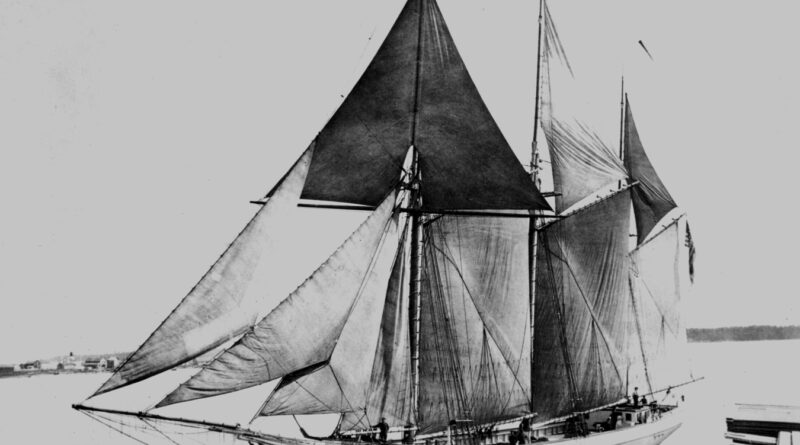The Christmas Tree Ship
While the tree is often a focal point for holiday festivities, imagine the shock when divers found one standing properly on the deck of the shipwrecked schooner SV Rouse Simmons, which had been lost on Lake Michigan in 1912.
The SV Rouse Simmons, now known as the “Christmas Tree Ship,” sailed from Michigan to Chicago for more than 30 years in the early 20th century, delivering Christmas trees to families in the city. It has since become a part of maritime history in the Great Lakes region.
The discovery of its remains decades later opened an archaeological investigation into the vessel’s history, including its final voyage.
The Rouse Simmons was a three-masted schooner built in 1868 by Allan, McClelland, and Company in Milwaukee, Wis. Her registered dimensions were 124.2 feet in length, 27.6 feet in breadth and 10.1 feet in depth of hold. Originally constructed for the lumber trade, the vessel was primarily used to transport lumber and other cargo across the Great Lakes. From 1890, brothers August and Herman Schuenemann, both Great Lakes sailing captains, invested in partial ownership of such vessels. The Schuenemanns envisioned bringing Christmas trees from northern Michigan to Chicago, where the demand for fresh-cut trees was high.
According to wisconsinshipwrecks.org, “many Christmas tree ships sold their cargo to wholesalers. Other captains, however, turned their ships into floating tree lots along the Chicago River, welcoming customers aboard and taking great pride and pleasure in their business. Each November, the captains Schuenemann loaded the schooner the Rouse Simmons with evergreens in Thompson, Mich.”
After sailing south, the captains moored their vessel to a downtown pier, hoisted a decorated tree up the mast and strung electric lights throughout the rigging, turning the ship into a giant Christmas decoration. This display was often referred to as the official beginning of that year’s holiday season.
The Schuenemanns bought vessels late in their careers, purchasing the most inexpensive senior schooners, wringing them out for their last bit of life and profiting from them in the lumber trade. The Rouse Simmons was already 42 years old when Herman Schuenemann purchased his 1/8 interest – a very old and worn boat by any standards.
The most infamous chapter in the ship’s history occurred on Nov. 23, 1912. The Rouse Simmons, laden with Christmas trees, left Thompson bound for Chicago, never arriving at her destination. A strong winter storm had struck Lake Michigan, and the ship, overloaded with trees and ice, sank in the frigid waters. Captain Herman Schuenemann, along with the crew, perished in the tragedy. The location of the Rouse Simmons wreck remained a mystery for 59 years. Christmas trees washed up along the coastline for years after the wreck. In 1923, Captain Schuenemann’s wallet came up in a fisherman’s net near Two Rivers, Wis. It was not until 1971, when Milwaukee diver Kent Bellrichard discovered the vessel’s remains 12 miles northeast of Two Rivers in 165 feet of water, that the story began to unfold.
Rouse Simmons had been flying a distress flag five miles offshore while driving a northwest gale southward. With no hope of catching the drifting ship, the Kewaunee station’s captain telephoned the Two Rivers’ Life-Saving Station, 25 miles to the south. The station quickly launched a lifeboat to thwart the distressed vessel and bring the crew to safety. However, the Rouse Simmons had vanished when the lifeboat set sail on the lake.
After reviewing historical records, it was uncovered that contrary to the famous story that the vessel had just vanished in front of the life-saving vessel heading towards her, the ship was lost under precise conditions.
“By recreating the search pattern of the Two Rivers lifeboat and comparing it with the Rouse Simmons’ location today, the [Wisconsin Historical Society] WHS deduced that the Two Rivers lifeboat completely encircled the Rouse Simmons and was never more than a few miles from where she lies,” says an article from wisconsinshipwrecks.org. “With a reported six miles of visibility that day, if the ship were still afloat as the lifeboat rounded Two Rivers Point at 4:20 p.m., the life-saving crew would have seen her. Additionally, the snowstorm that many lake captains reported as “the worst they had ever seen” may well have been terrible, but it began around 5 p.m.—well after the Rouse Simmons would have been on the bottom.”
Today, the story of the Rouse Simmons continues to be remembered and honored through various events, even though she lies six miles northeast of Rawley Point in Manitowoc County at 44 degrees 16.640’ N, 087 degrees 24.863’ W. Her legacy lives on at annual events, including the annual Christmas Ship Parade on Lake Michigan, where a modern-day vessel is decked out with holiday lights and sails in honor of the tradition started by Captain Herman Schuenemann and the original Christmas Tree Ship.



The Christmas Ship tradition continues to this day. The Coast Guard icebreaker, USCGC Mackinaw, home port Cheboygan, Michigan, travels the length of Lake Michigan picking up navigational buoys for the winter and delivers Christmas trees to Chicago for deserving families. The cutter Mackinaw stops at 44 degrees 16.640’ N, 087 degrees 24.863’ W to lay a wreath at the site of the sunken Rouse Simmons.